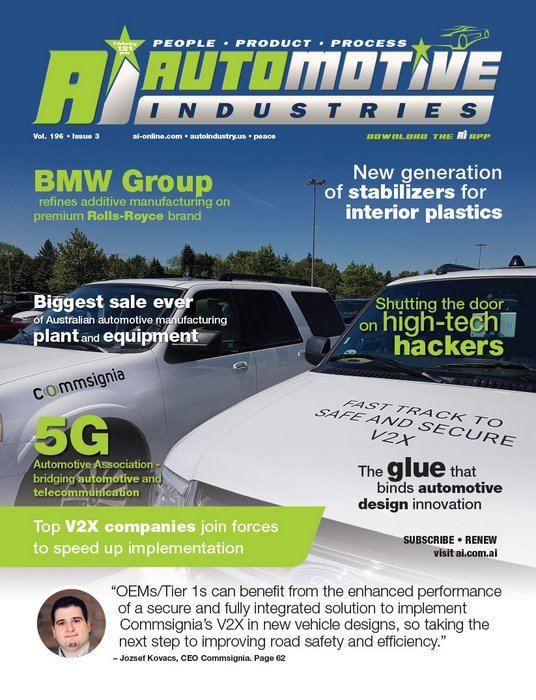Three of the world leaders in vehicle communication (V2X) are collaborating to meet the rapidly-growing demand for reliable Vehicle to Vehicle (V2V) and Vehicle to Infrastructure (V2I) technology.
They are u-blox, Commsignia and NXP Semiconductors. “Commsignia leads the market with the best end to end V2X software suite for connecting cars and smart city infrastructure,” said Jozsef Kovacs, CEO of Commsignia. “Our collaboration with NXP and u-blox is an excellent example of leading players combining their strengths to bring the latest V2X technologies to market.”
Automotive Industries (AI) asked Kovacs what the collaboration means in practical terms for OEMs and Tier automotive companies.
Kovacs: An integrated module and V2X software solution, that works “out of the box”, accelerates time to market and lowers integration costs for OEM and Tier 1s. When designing V2X connectivity products, engineers won’t have to spend valuable project time combining multiple hardware components – a wireless radio chip with its housing, an advanced GNSS (Global Navigation Satellite Solution) and a state of the art security chip- with the corresponding V2X software.
AI: What is the Commsignia approach to V2X module and chip makers?
Kovacs: We want to offer OEM / Tier1s a “best-in-class” V2X software that is compatible with the latest modules and components on the market. With this approach, we reduce complexity for the OEM / Tier 1 so that they can focus on the core functionality of the final product. Over the past few years we have implemented our software on the major V2X silicon chip suppliers on the market (inc. NXP, Autotalks, Marvell, Renesas). We have also worked with module makers (inc. u-blox, ALPS, Murata and LG Inotech) to show the advantages of a module solution pre-integrated with Commsignia software. These components all satisfy the V2X standard criteria, despite some differences in architecture, security and other features.
AI: What is Commsignia doing to ensure V2X data security?
Kovacs: Contrary to other software suppliers on the market, Commsignia developed a robust PKI security solution as an integral part of its V2X software offering. This approach ensures that the software can cope with the high demand on availability without sacrificing performance. We then took a step further and reinforced the implementation to support hardware security modules. The result is like the security chip in most laptops. You can tamper with it, but you will never be able to extract the data that is essential to protect the integrity of V2X communication. This has proven successful. We were the first company to interface with the Security and Credential Management System operated by the United State Department of Transportation, a system responsible for the enrolment of new vehicles that will securely share sensor data via V2X.
AI: Another exciting development is the Connected Vehicle Pilot Deployment Project of the Tampa Hillsborough Expressway Authority (THEA). Please tell us about the significance of that project.
Kovacs: The Tampa Connected Vehicle Pilot will employ vehicle-to-vehicle (V2V) and vehicle-to-infrastructure (V2I) communication technology to improve safety and traffic conditions in downtown Tampa. This was one of three sites to be selected for the U.S. Department of Transportation (USDOT) Connected Vehicle Pilot Deployment Program. The four-year program began in September 2015, and reached an important milestone in September 2016 when USDOT authorized THEA and its partners to proceed with design, testing and deployment.
Later this year the Tampa Connected Vehicle Pilot will begin equipping buses, streetcars, and privately-owned vehicles with Dedicated Short-Range Communication (DSRC)-based V2X technology. Vehicles participating in the pilot project will be equipped with in-vehicle displays, antennas and radio communication devices called onboard units. Roadside units will be deployed in infrastructure such as traffic lights. Equipped vehicles will be able to communicate with each other as well as with traffic signals, crosswalks and other elements of the transportation infrastructure. Commsignia is an approved supplier to the pilot, and I expect that we will supply a significant number of the onboard units (OB3) for the 1,600 cars, 10 buses and 10 trolleys that are foreseen at this stage. The pilot’s goal is to provide drivers, transit riders and pedestrians (who download the app on their smart phones) with a range of safety and mobility benefits. Commsignia’s V2X software in the connected vehicles will warn their drivers of a variety of safety hazards addressing the six key mobility concerns of downtown Tampa:
- Wrong Way Entries – safety concerns will be addressed by warnings of attempted wrong-way entries at intersections
- Pedestrian Safety – V2X solutions will be used to reduce pedestrian-vehicle incidents caused by driver’s lack of attention or pedestrians taking shortcuts
- Traffic Progression Enhancement – the interaction of traffic nodes will be optimized by V2X solutions to reduce congestion and pedestrian incidents
- Morning Peak Hour Queues – vehicles equipped with V2X technology will assist drivers to make safe and smooth lane changes during peak hours
- TECO Trolley Conflicts – streetcar operators, bus drivers, auto drivers, and pedestrians will be provided information to reduce crashes and incidents with pedestrians near streetcar stops
- BRT Signal Priority Optimization, Trip Times and Safety – delays caused by congestion in the proximity of bus stops will be addressed by optimized lane prioritization in order to improve traffic flow.
The third and final phase of the pilot is expected to begin in mid-2018 and will involve the full-scale operation of connected vehicle technology throughout downtown Tampa. This project will be a great showcase for Commsignia to demonstrate the benefits of its V2X technology in a real-life deployment in the US using a full range of products from our Automotive and Smart City portfolios.
AI: What role will dedicated short range communication technology play in connected cars of the future? How much closer are we to fully autonomous vehicles?
Kovacs: The majority of innovations developed for the self-driving car are based on line-of-sight sensors with decisions based on the car’s local perception. However, there are still real-life situations that will challenge these light of sight sensors. A real-life example is two vehicles approaching an intersection in a perpendicular direction where a building obscures the sight of each car. Being wireless, V2X overcomes this issue as it “can see round corners” and trigger warnings to the drivers to avoid a side collision.
To make autonomous cars more responsive we need to enable “cooperative perception”. Cooperative perception between cars and infrastructure gives the vehicle a combined view (line of sight sensors plus V2X) of how each car sees the world around them. DSRC currently allows the sharing of sufficient quantified sensor information to warn the drivers and control the vehicle to avoid fatal accidents. As the number of sensors and information quality increases, so the need for the car to process this data will also increase. Some car makers estimate that a bandwidth as high as 10GBit/s is needed to share the raw lidar, radar, camera images and V2X data between multiple vehicles. Put in perspective this is 100x higher than a standard cell phone’s capability today. The solution for the problem is likely to be 5G which among many things will bring the increased bandwidth to satisfy the needs of self-driving cars in the next 5-10 years














































 New lifetime solution for diesel emission measurement
New lifetime solution for diesel emission measurement Innovative and holistic approach to providing in-vehicle information
Innovative and holistic approach to providing in-vehicle information Automotive innovation again steals the show
Automotive innovation again steals the show Staying on track with powertrain development
Staying on track with powertrain development Biggest sale ever of Australian automotive manufacturing plant and equipment
Biggest sale ever of Australian automotive manufacturing plant and equipment


